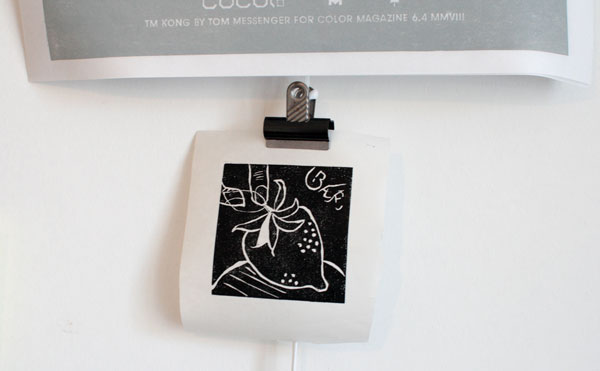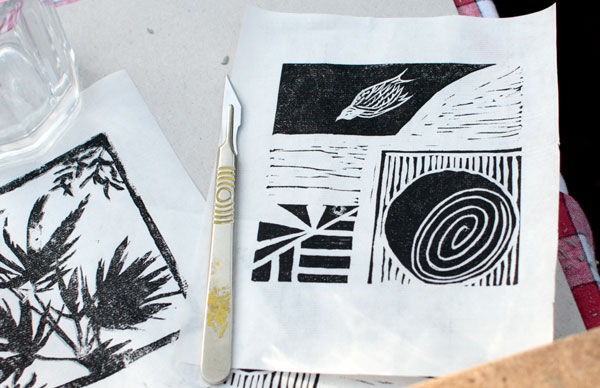Lino printing day
Sometimes, just occasionally, it’s nice to partake in crafts that don’t involve wool, or even fabric, so I was delighted to be invited round to my friend Sofie’s house to learn how to do lino printing. Sofie’s BF, illustrator Tom Messenger, does amazing things with lino printing and he kindly offered to show us the basics.

Tom's amazing lino prints
I’d always thought of lino printing as hap-hazard and earthy, but Tom’s precise, multi-layered, multi-tonal pieces totally challenged my assumptions about the medium.
Tom asked us to bring a design idea, I had a few in mind, including this photo of a circuit board (I’ve always thought those things were kind of beautiful, odd I know). But, I settled on something safer and more traditional – this photo of my Japanese Maple tree I took on my iPhone using the Hipstamatic medium-format app.
There are various ways of transferring an image to lino and many decisions to be made; how much detail to include, which areas to print and which to clear, to cut outlines or solid areas etc. I sketched my image directly onto the lino in pencil, I cleared the white areas on the photo so that the leaves would be printed and the sky, not. I like the photo border so I kept a border on my lino, I think it frames the abstract leaf shapes nicely.
My design turned out to be rather complicated. Although I started cutting first, I was the last to finish. What can I say? I like a challenge. I mainly cut with a scalpel in order to achieve the sharp edges, although there were special gauging tools in a variety of sizes. At first I worked painstakingly, trying to be precise, by the end I was cutting as fast as I could just to finish. If anything I prefer the areas I did at the end as they were more geometric, although I accidentally gauged out a few extra bits.

My lino, with ink

Inking up
A thick, linseed oil-based ink is used. It’s applied to the lino with a roller, after spreading on a glass surface to ensure an even coverage.
Lino printing is normally done on thick paper, similar to watercolour paper, and put through a letterpress. However, Tom prefers a fine-grained, off-white Japanese paper that is thin, yet strong. To transfer to ink to the paper, the paper was laid over the lino and pressed with the back of a spoon in a circular motion.
Up until the final moment when I peeled the paper from the lino, I was convinced that my image would not be recognisable. No one was more surprised than me at the results.

My print
Not the most expert execution but I’m really happy with it! I think the combination of the Japanese aesthetic, the fine paper and the plain black ink all come together.
Everyone finished the day with a successful print, it was really interesting to see how different they all were.

Hanne's print

Sofie's print

Kirstie's print
Let’s not forget the real reason we get together for craft days…

Mmm... cake
